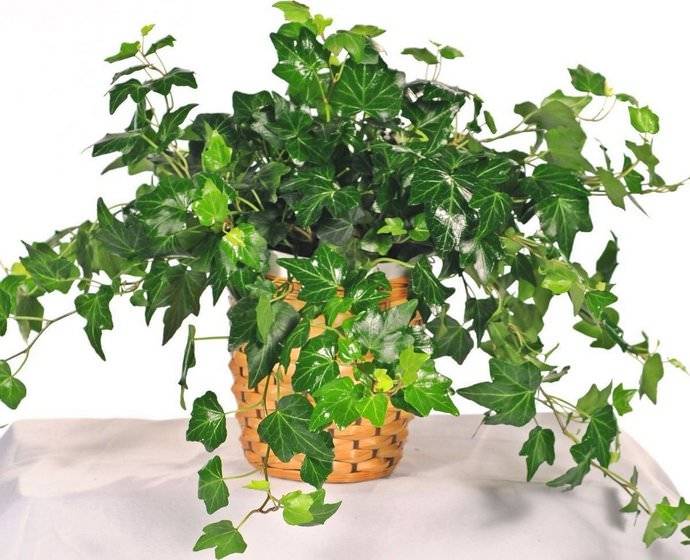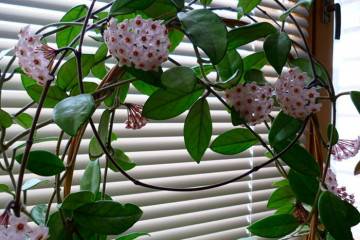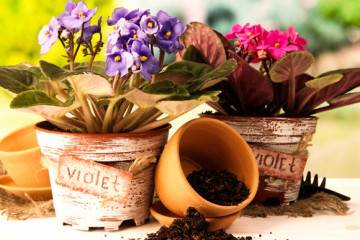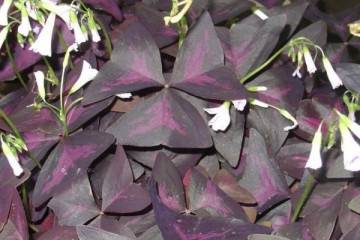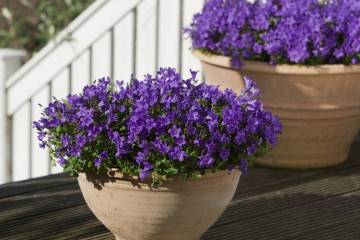Flower ivy indoor variegated ordinary
Content:
Indoor ivy is most often grown as a home plant by a liana, is unpretentious in care and does not require special conditions of detention. Moreover, its abundant and bright foliage is able to decorate any room.
Appearance and description of indoor ivy
Indoor ivy, or hedera, is a plant with hanging shoots, which are covered with decorative deltoid leaves of a deep green color. Florists love it very much for its versatility, as it looks impressive both as a single plant and in composition with other, especially flowering, indoor plants (most often it is pelargonium or fuchsia).
A specific feature of indoor ivy is the presence of adventitious roots, due to which the plant in natural conditions clings tightly to the walls and tree trunks. At home, for this purpose, special supports are arranged for the plant.
Casting at ivy leathery dense. They are of two types: on the shoots that do not bloom, the leaves are dark green, angular-lobed in shape, and the shoots that bloom are distinguished by light green leaves and have a lanceolate shape.
How ivy blooms can be seen if the plant is provided with optimal conditions. Its flowers are small, gather in racemose or corymbose inflorescences on the tip of the shoots. At the end of flowering, black or light-colored berries with several seeds inside are formed in place of the flowers.
Popular species and varieties
The most popular variety among florists is English ivy. But for growing at home, the following types of ivy are also chosen:
- ordinary. It is a creeping vine with alternate simple leaves. The color of leathery foliage is dark green, light streaks are present. The brightest varieties of this species are Jubilee, Harald, Kholibra, Ivalice;
- Colchian. This species is distinguished by thin shoots and large leathery leaves. At the same time, the dark green foliage gives off a nutmeg aroma. Some varieties of this species have a particularly decorative appearance due to the variegated color of the foliage, for example, Dentata Variegata has oval leaves with yellow edges, Sulfur Heat has yellow-green stripes, and Arborescens has drooping branches with oval leaves;
- canary. These climbing plants have large triangular leaves of a dark green color and specific pale veins on them. The most colorful varieties of the species are Variegata, Brigitte, Golden leaf (with sufficient light on the leaves, a golden tint is clearly visible).
Features of ivy care at home
Ivy is a plant that does not cause much trouble to grow. It adapts to any conditions of detention. But at the same time, you can get a luxurious decorative indoor ivy flower by providing it with optimal care.
The plant is very rarely sick, and the appearance of diseases, like insect pests, indicates gross violations of the rules for caring for the crop.
Reproduction of a plant also does not cause any difficulties. For the cultivation of ivy, cuttings are used, as well as propagation by branches and shoots.
Humidity and temperature
With regard to the temperature regime, home ivy is well tolerated. It can withstand both rather high temperatures in summer and lower temperatures in winter. The temperature range for normal plant development is 16-25 ° C.
Despite the fact that ordinary indoor ivy does not impose special requirements for humidity and is able to tolerate both dry and humid air well, on hot days it is advisable to irrigate its dense foliage daily.
Watering
Watering is considered optimal for ivy at home when the top layer of the substrate dries. The plant can easily survive several days of drought. But frequent excessive watering, in which stagnation of moisture in the soil is formed, is fraught with root rot. Their appearance threatens the plant with death. Therefore, when transplanting ivy, be sure to pour a layer of drainage material on the bottom of the pot.
For irrigation, it is better to use soft, settled water, ideally rain or melt.
Choosing the right place
Home ivy is best placed in light partial shade. For a while, it is allowed to place it in the shade, but it should be remembered that with a prolonged lack of lighting, ivy loses its decorative effect, especially its variegated varieties. A place shaded from bright sunlight will be optimal for the good development of the plant.
You also need to know that the ivy flower does not particularly favor frequent rearrangements and changes of place, especially if the source of light changes. It may start to dry.
Decorative ivy loves fresh air and reacts well to a draft, so it is worth regularly ventilating the room in which the plant is located.
Fertilizers and feeding
During the active growing season, ivy in a pot should be regularly fed. From mid-spring to late autumn, it is advisable to do this twice a month. It is desirable to use complex mineral fertilizers intended for deciduous plants.
Houseplant ivy: benefit or harm
There are many superstitions that are associated with the perceived benefits or harms of keeping a heder at home. At the same time, opinions about the properties of the plant are fundamentally opposite. So, lovers of this culture assure that this is a good version of a houseplant, and it is capable of:
- promote harmony and peace between family members;
- absorb negative energy and prevent conflicts;
- produce a calming effect on overly active children;
- replenish the reserves of vitality, therefore ivy is often bred in office rooms;
- help girls and women get married successfully.
But their opponents, on the contrary, say that ivy is a home flower, which:
- absorbs the positive energy of people and turns it into negative;
- does not give women the opportunity to find their soul mate;
- able to bring squabbles, quarrels and material losses into the house.
Believe it or not in such statements and keep this plant in your home or not is everyone's business.It can be unambiguously argued that ivy is unpretentious in care, adapted to living in a city apartment. It is resistant to many diseases and pests, and lends itself well to reproduction. Ivy, its flowers, especially lush rich foliage, are able to decorate and revitalize any room.



